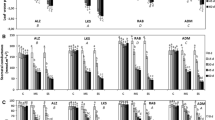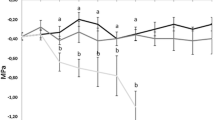Summary
In order to better understand the adaptations of Astragalus tennesseensis Gray (Leguminosae) to its summer-dry cedar glade habitat, comparisons were made of the free amino acids and amides in leaves of drought- and nondrought-treated plants. No qualitative differences were detected; 13 free amino acids and 2 amides were identified. However, water stressed plants showed a 115% increase in the total amount of amino acids and amides over nondrought stressed plants. Proline accounted for 30.1% of the increase and aspartic acid 37.1%. Water stress caused an increase in the 2 amides and in 11 of the 13 amino acids; alamine and serine decreased. Upon rewatering, the total amount of amino acids and amides quickly decreased. The ability to accumulate proline and aspartic acid may be of adaptive value to A. tennesseensis during short periods of drought.
Similar content being viewed by others
References
Barnett, N. M., Naylor, A. W.: Amino acid and protein metabolism in Bermuda grass during water stress. Plant Physiol. 41, 1222–1230 (1966)
Baskin, C. C., Baskin, J. M., Quarterman, E.: Observations on the ecology of Astragalus tennesseensis. Amer. Midl. Nat. 88, 167–182 (1972)
Baskin,C. C., Quarterman, E.: Germination requirements of seeds of Astragalus tennesseensis. Bull. Torrey Bot. Club 96, 315–321 (1969)
Caudle, C. F.: Studies on the life history and hydro-economy of Astragalus tennesseensis (Leguminosae). Ph.D. Diss., Vanderbilt University, Nashville, Tennessee. 182 pp. (1968)
Chen, D., Kessler, B., Monselise, S. P.: Studies on water regime and nitrogen metabolism of citrus seedlings grown under water stress. Plant Physiol. 39, 379–386 (1964)
Eaton, F. M., Ergle, D. R.: Carbohydrate accumulation in the cotton plant at low moisture levels. Plant Physiol. 23, 169–187 (1948)
Henckel, P. A.: Physiology of plants under drought. Ann. Rev. Plant Physiol. 15, 363–386 (1964)
Iljin, W. S.: Drought resistance in plants and physiological processes. Ann. Rev. Plant Physiol. 8, 257–274 (1957)
Kemble, A. R., MacPherson, H. T.: Liberation of amino acids in perennial rye grass during wilting. Biochem. J. 58, 46–49 (1954)
Kessler, B.: Nucleic acids as factors in drought resistance in higher plants. Rec. Advanc. Bot. 2, 1153–1159 (1961)
Loomis, W. D., Stumpf, P. K.: The special role of individual amino acids in plant metabolism. In: Encyclopedia of plant physiology, vol. 8, Nitrogen metabolism, W. Ruhland, Ed., p. 262–276. Berlin: Springer 1958
Petrie, A. H. K., Wood, J. G.: Studies on the nitrogen metabolism of plants. I. The relation between the content of proteins, aminoacids, and water in the leaves. Ann. Bot. (Lond.), N.S. 2, 33–60 (1938a)
Petrie, A. H. K., Wood, J. G.: Studies on the nitrogen metabolism of plants. III. On the effect of water content on the relationship between proteins and amino-acids. Ann. Bot. (Lond.), N.S. 2, 887–898 (1938b)
Routley, D. G.: Proline accumulation in wilted Ladino clover leaves. Crop Sci. 6, 358–361 (1966)
Saunier, R. E., Hull, H. M., Ehrenreich, J. H.: Aspects of the drought tolerance in creosotebush (Larrea divaricata). Plant Physiol. 43, 401–404 (1968)
Shiralipour, A., West, S. H.: Effects of water stress on amino acids, proteins and DNA content of corn shoot at different ages. Soil and Crop Sci. Soc. Fla. 28, 115–122 (1968)
Singh, T. N., Aspinall, D., Paleg, L. G.: Proline accumulation and varietal adaptability to drought in barley: A potential metabolic measure of drought resistance. Nature (Lond.) New Biol. 236, 188–190 (1972)
Stewart, C. R., Morris, C. J., Thompson, J. F.: Changes in amino acid content of excised leaves during incubation. II. Role of sugar in the accumulation of proline in wilted leaves. Plant Physiol. 41, 1585–1590 (1966)
Tarchevskii, I. A., Siyanova, N. S.: Effect of drought on the postphotosynthetic transformation of carbon in wheat leaves. Soviet Plant Physiol. 9, 429–434 (1963)
Thompson, J. F., Stewart, C. R., Morris, C. J.: Changes in amino acid content of excised leaves during incubation. I. The effect of water content of leaves and atmospheric oxygen level. Plant Physiol. 41, 1578–1584 (1966)
West, S. H.: Protein, nucleotide and ribonucleic acid metabolism in corn during germination under water stress. Plant Physiol. 37, 565–571 (1962)
White, A., Handler, P., Smith, E. L.: Principles of biochemistry, 3rd ed. New York: McGraw-Hill 1964
Author information
Authors and Affiliations
Additional information
This research was supported by funds from an NIH Biomedical Sciences Support Grant to the University of Kentucky. This support is gratefully acknowledged.
Rights and permissions
About this article
Cite this article
Baskin, C.C., Baskin, J.M. Responses of Astragalus tennesseensis to drought. Oecologia 17, 11–16 (1974). https://doi.org/10.1007/BF00345091
Received:
Issue Date:
DOI: https://doi.org/10.1007/BF00345091




